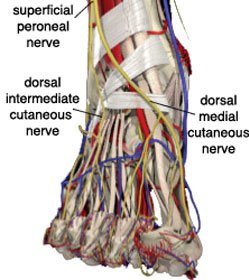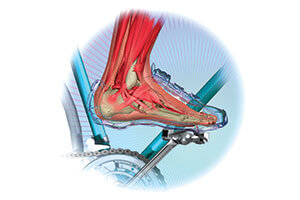Article by Fred Matheny
In cycling, it’s known as “hot foot” — a burning pain in the ball of the foot, perhaps radiating toward the toes. Severe cases feel like some sadistic demon is applying a blowtorch.
Hot foot occurs most often on long rides. It may develop sooner or more intensely on hilly courses because climbs cause greater pedaling pressure. The pain results when nerves are squeezed between the heads of each foot’s five long metatarsal bones. These heads are in the wide part of the foot (the “ball”) just behind the toes.
“Hot foot” is actually a misnomer. It’s not heat but rather pressure on nerves that causes the burning sensation. You’ll sometimes see riders squirting water on their pups in a vain attempt to put out the fire.
Besides tight shoes, another risk factor is small pedals, especially if you have large feet. Small pedal surfaces concentrate pressure on the ball of the foot instead of spreading it the way a larger pedal will. If your cycling shoes have flexible soles like most mountain bike shoes, they’ll be less able to diffuse pressure.
Here are several solutions for ‘Hot Foot.’
- Adjust shoe straps. It’s the top strap nearest your ankle that stops your feet from slopping around in your shoes. Tighten it as much as necessary, but keep the strap nearest your toes loose for maximum room.
- Use thinner insoles and/or socks. This will give your feet more room to swell without restriction, especially helpful if your shoes are borderline snug.
- Re-focus the pressure. Many riders solve hot foot by moving their cleats to the rear by as much as 8 mm. Long-distance enthusiast may go back as far as the cleat slots allow. They might even drill new rearward holes. After using this remedy, lower your saddle by the same amount if you moved your cleats backward 2-4 mm. If more than 4 mm, lower the saddle about half the amount. So, if your cleats go back 1 cm, put the saddle down 5 mm.
- Add metatarsal buttons. These foam domes are placed on insoles (or are built into them) just behind the ball of the foot. They spread the metatarsal bones so the nerves running between them aren’t pinched by pressure or swelling. You can find these products in the foot-care section of pharmacies.
- Switch to larger pedals, for the reason mentioned above.
- Buy new shoes. Look for a model with a wider-and-higher toe box, a stiffer sole and an anatomical footbed with a metatarsal button. One model that meets these specs is the Specialized BG, with versions for road and off-road.
- Purchase custom orthotics. These plastic footbeds are supplied by podiatrists or sports medicine clinics. Among their biomechanical benefits are built-in metatarsal buttons. Be certain the practitioner understands you’re a cyclist, because orthotics for runners are not what you need. Cycling is a forefoot activity, not a heel-strike activity.


Leave a Reply